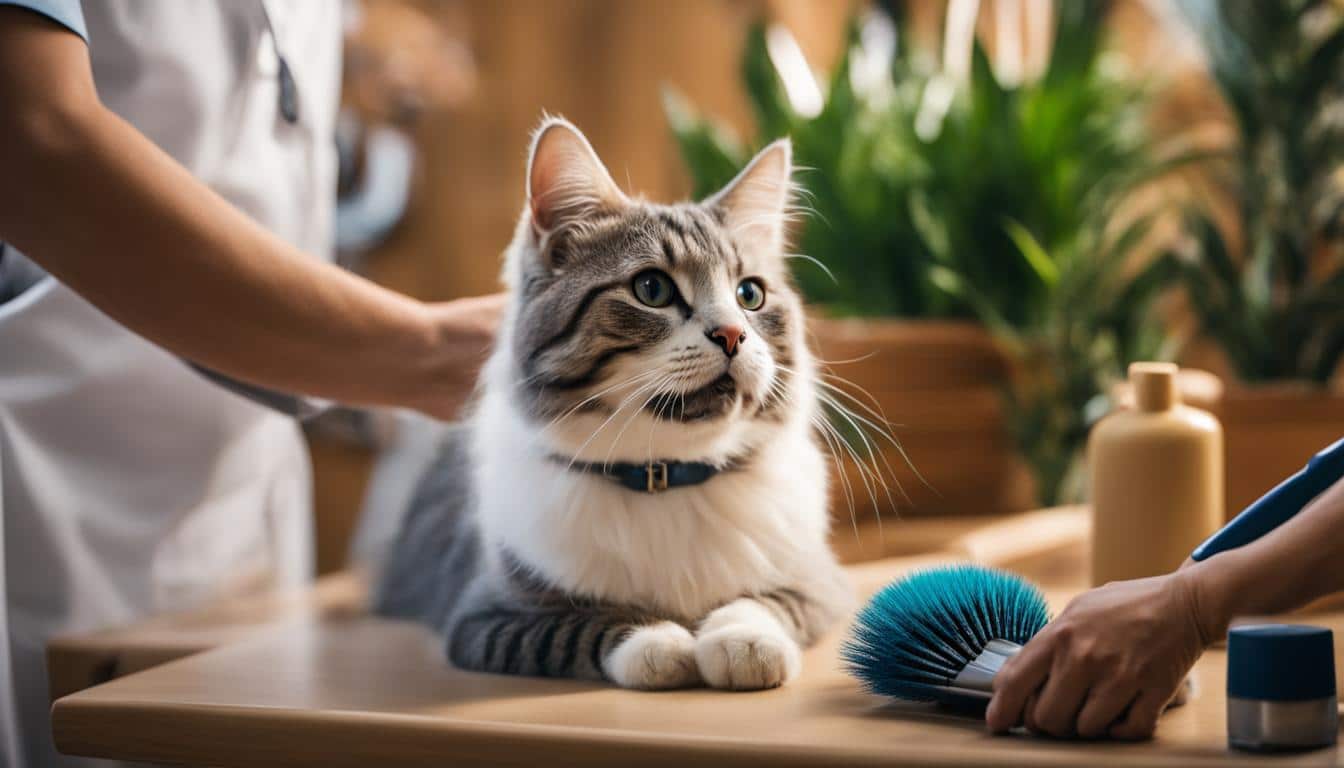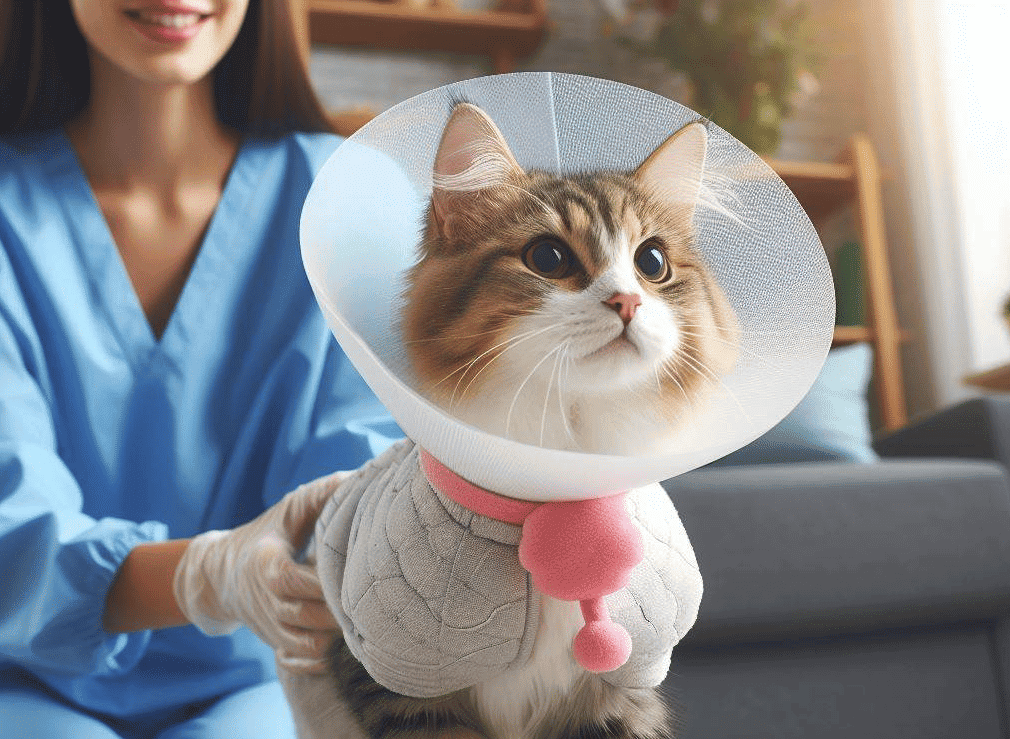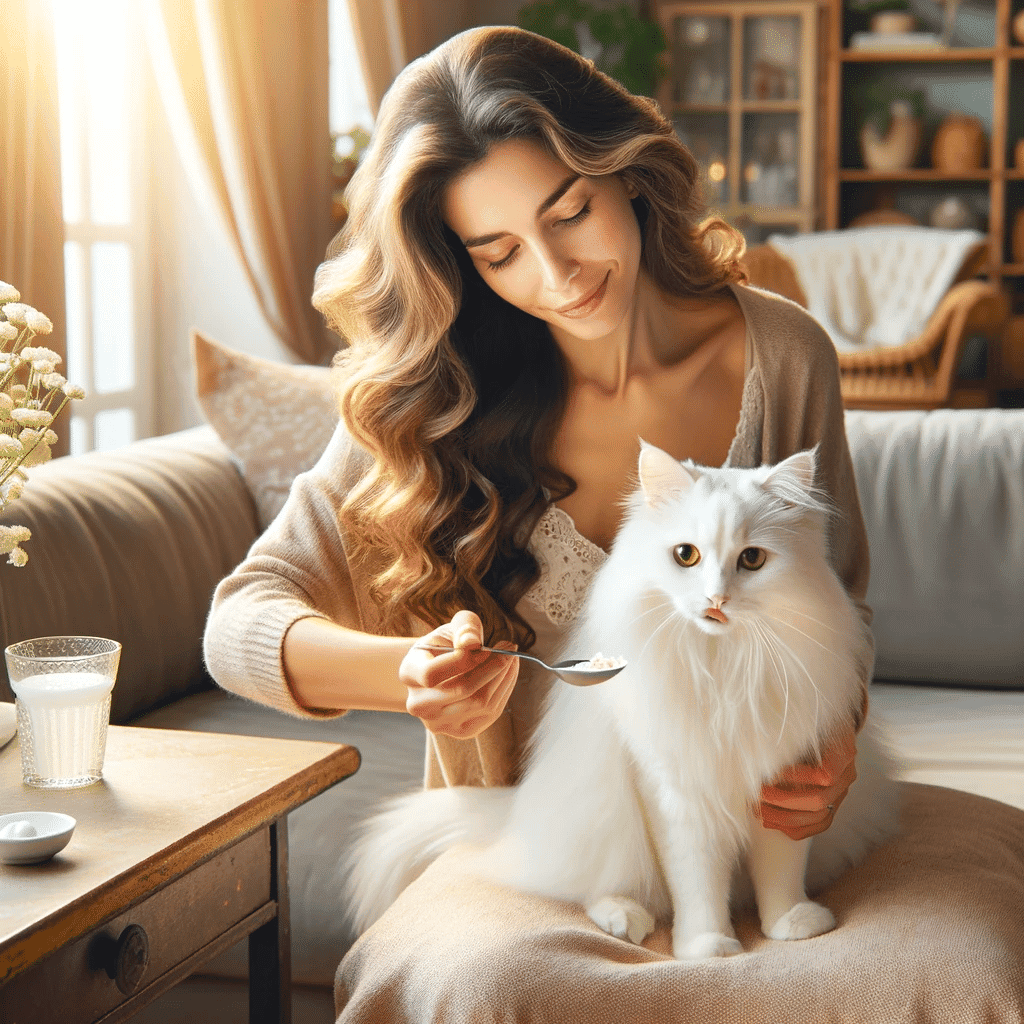
Cat overgrooming treatment might be necessary if it is happening to your cat.
Overgrooming is a common problem in cats where excessive licking and grooming leads to hair loss. It often happens due to different reasons, like pruritus, allergies, and stress.
To effectively treat cat overgrooming, it is important to identify the underlying cause and implement appropriate treatment options.
In this post, I will share various treatment options to help pet owners address their cat’s overgrooming behavior and promote overall feline health and well-being.
Brief Synopsis
Understanding and treating the causes of cat overgrooming involves addressing medical issues like allergies or infections with targeted treatments, and managing behavioral factors through environmental enrichment and stress reduction techniques.
Regular veterinary care and proper cat skin care are essential for effectively managing overgrooming and promoting healthy skin.
What is Cat Overgrooming?
Grooming is a natural behavior in cats, serving various purposes such as cleaning their fur, removing parasites, and regulating body temperature.
Cat grooming happens when they engage in repetitive licking and grooming, resulting in hair loss and potential self-inflicted wounds.
Cat overgrooming typically follows certain patterns, with the ventral abdomen, hind legs, and perineum being commonly affected areas.
To diagnose the condition accurately, it is important to distinguish overgrooming from other causes of hair loss, such as infections or hormonal imbalances.
Overgrooming is often associated with feline symmetrical alopecia (FSA), which can caused by itchiness or pruritus.
Managing cat skin conditions is a key aspect of addressing overgrooming.
By identifying and treating the underlying cause of the excessive grooming behavior, such as allergies or skin infections, it is possible to alleviate the urge to groom excessively.
Proper diagnosis and veterinary care are compulsory in determining the appropriate treatment plan for cat overgrooming.
Causes of Cat Overgrooming |
Symptoms |
|---|---|
| Allergies | Hair loss, redness, and inflammation |
| Stress and anxiety | Bilateral hair loss, especially on the abdomen and hind legs |
| Parasites | Intense itching, scratching, and hair loss in the affected areas |
Causes of Overgrooming
Understanding the underlying causes of overgrooming in cats is crucial for effective treatment.
Many factors could trigger overgrooming, e.g. skin problems, allergies, stress, or behavioral issues.
Veterinary care and a thorough examination can help identify and address these triggers.
Common Overgrooming Triggers
One of the main causes of overgrooming in cats is pruritus, which refers to itching or skin irritation.
Pruritus can result from various factors, such as flea infestations, skin infections, or allergies. Identifying and treating these underlying conditions is vital in managing overgrooming behavior.
In addition to medical causes, stress and anxiety can also lead to overgrooming in cats.
Environmental changes, lack of stimulation, or conflicts with other pets may contribute to feline stress levels.
Creating a calm and enriched environment for your cat can help reduce the likelihood of overgrooming.
Overgrooming Treatment: Medical Causes
The veterinarian will conduct a thorough examination – including a comprehensive medical history and diagnostic tests, to accurately diagnose the underlying condition and determine the most appropriate treatment plan for your cat.
If your cat’s overgrooming is caused by medical issues such as allergies or skin infections, targeted treatment options can help alleviate the condition.
Your veterinarian might recommend various cat skin care techniques to address the underlying causes and provide itching relief medication.
One common treatment is using medicated shampoos specifically formulated to treat their skin problems.
These shampoos often contain ingredients that help soothe the skin and reduce inflammation.
Applying the shampoo (as advised by your veterinarian) can help improve your cat’s skin health and reduce the urge to overgroom.
In some cases, topical ointments or creams may be prescribed to target specific areas of irritation or infection on your cat’s skin.
These products can help alleviate symptoms and promote healing.
Oral medications, such as antihistamines or corticosteroids, may also be recommended to manage underlying allergies or inflammation triggered by overgrooming behavior.
Treatment Options for Medical Causes of Overgrooming |
Benefits |
|---|---|
| Medicated shampoos | Soothe the skin, reduce inflammation, and promote healing |
| Topical ointments or creams | Target specific areas of irritation or infection |
| Oral medications | Manage allergies or inflammation contributing to overgrooming |
Overgrooming Treatment: Behavioral Causes
Behavioral modification techniques can help reduce the urge to overgroom and manage feline self-inflicted wounds.
Creating a calm and enriched environment for your cat can help promote a healthy grooming pattern and minimize overgrooming behaviors.
To reduce cat stress, consider providing a stable routine for your feline companion.
- Cats thrive on consistency, so maintaining a predictable schedule can help alleviate anxiety and stress.
- Additionally, offering hiding places, interactive toys, and vertical space in your home can provide mental and physical stimulation, reducing the likelihood of overgrooming.
- Positive reinforcement techniques are effective in encouraging healthy grooming patterns. For example: rewarding desired behaviors.
Understanding Cat Grooming Patterns
Each cat has its unique grooming patterns.
Some cats may groom more frequently than others, and certain areas (of their body) may receive more attention.
Observing your cat’s grooming habits can provide valuable insights into their behavior and help identify abnormal overgrooming tendencies.
Paying attention to grooming patterns can assist in pinpointing potential triggers, such as specific areas of discomfort or stressors in the environment.
In cases of overgrooming, feline self-inflicted wounds can occur. These wounds can lead to skin irritation, inflammation, and even infection.

Consulting with a veterinarian can provide additional guidance on managing feline self-inflicted wounds caused by overgrooming.
Grooming Tips: |
Benefits: |
|---|---|
| Regularly brush your cat’s coat | Promotes healthy skin and removes loose hair |
| Provide scratching posts and toys | Redirects grooming behavior and relieves stress |
| Create a calm and enriched environment | Reduces anxiety and promotes overall well-being |
Consultation with a Veterinarian
A thorough examination by a veterinarian can help determine if the overgrooming is due to medical issues or behavioral factors.
Your cat’s skin and coat will be carefully examined for any abnormalities or signs of overgrooming.
This allows the veterinarian to rule out any underlying dermatological issues and address any cat dermatological issues that may be causing or exacerbating overgrooming behavior.
Diagnostic tests such as skin scrapings or blood tests may also be conducted to investigate the underlying causes.
Once the triggers are identified, the veterinarian can recommend appropriate treatment options, ranging from medication to behavioral modifications.
They can guide proper grooming practices and offer advice on creating a stress-free environment for your cat.
Treatment Options |
Description |
|---|---|
| Medicated Shampoos | Special shampoos formulated to alleviate itching and soothe the skin can be used to manage overgrooming caused by skin conditions or allergies. |
| Topical Ointments | Applying topical ointments, creams, or sprays directly to the affected areas can relieve itching and promote healing. |
| Oral Medications | Oral medications, such as antihistamines or corticosteroids, may be prescribed to address underlying allergies or inflammation. |
| Elimination Diets | If food allergies are suspected as a cause for overgrooming, a hypoallergenic or novel protein diet may be recommended to identify and eliminate the offending ingredients. |
Every cat is unique, and the causes of overgrooming can vary. It is important to consult with a veterinarian for a proper diagnosis and tailored treatment plan for your cat’s specific needs.
Reducing Cat Stress and Stress-Free Environment
Stress can significantly contribute to cat overgrooming behaviors, and creating a stress-free environment is crucial for managing this issue.
By implementing various techniques, you can help reduce stress levels in your feline companion and promote a healthy and balanced lifestyle.
Methods for Reducing Cat Stress
- Establish a Stable Routine: Cats thrive on routine and familiarity, so providing a consistent schedule for feeding, playtime, and rest can help reduce stress and create a sense of security.
- Offer Hiding Places: Create hiding spots around your home, such as beds, boxes, or dedicated cat trees. It gives your cat a safe hiding place when feeling anxious or overwhelmed.
- Provide Interactive Toys: Engaging your cat in playtime with interactive toys can help stimulate their mind and body, alleviating stress and preventing boredom.
- Ensure Vertical Space: Cats love to climb and observe their surroundings from high vantage points. Providing vertical space with cat towers or shelves makes them feel secure and in control of their environment.
- Practice Positive Reinforcement: Rewarding your cat’s good behavior with treats or praise can help build trust and strengthen the bond, reducing stress and promoting a positive environment.
Stress Reduction Techniques |
Benefits |
|---|---|
| Establishing a stable routine | It will provide a sense of security and familiarity |
| Offering hiding places | It will give cats a safe space to retreat to when stressed |
| Providing interactive toys | Stimulates the mind and body, reducing stress and boredom |
| Ensuring vertical space | Allows cats to feel secure and in control of their environment |
| Practicing positive reinforcement | Strengthens the bond between you and your cat, promoting a positive environment |
Cat overgrooming can be distressing for both you and your feline companion.
By addressing the medical and behavioral causes of overgrooming, you can work towards promoting a healthier and stress-free environment for your cat. Veterinary care is essential in identifying underlying medical conditions and providing appropriate treatment.
With your dedication to your cat’s well-being and the guidance from a veterinarian, you can effectively manage cat overgrooming and ensure a happy and healthy life for your feline friend.
FAQ
How can I treat my cat’s overgrooming?
The treatment for cat overgrooming depends on the underlying cause. It may involve medicated shampoos, topical ointments, oral medications, or behavioral modification techniques.
When should I seek veterinary care for my cat’s overgrooming?
It is important to seek veterinary care if your cat is overgrooming excessively. A veterinarian can help diagnose the underlying cause and provide appropriate treatment options.
How often should I groom my cat to prevent overgrooming?
Regular grooming sessions with appropriate brushes or combs are important for cat skin care. The frequency of grooming depends on your cat’s coat type and individual needs.
Can diet affect my cat’s skin and prevent overgrooming?
Yes, a balanced and nutritious diet can support healthy skin and reduce the risk of skin problems that may lead to overgrooming. Consult with a veterinarian for dietary recommendations.
Useful Reads
- https://rainiervet.com/solutions-for-an-over-grooming-cat/
- https://petmd.com/cat/general-health/how-tell-if-your-cat-over-grooming
- https://vetfocus.royalcanin.com/en/scientific/overgrooming-in-cats

In her previous life, Lisa traveled extensively, both for work and leisure. After the pandemic struck, Lisa locked up her luggage and adopted a cat ever since.
Lisa is now an avid cat lover, she devotes most of her free time serving as butler to her adorable feline at home. When she is not with her cat, she can be seen using her phone sourcing for the latest cat supplies online.


